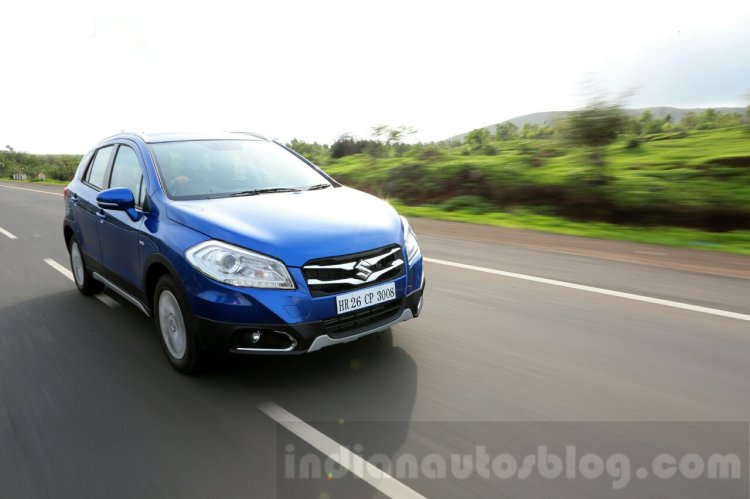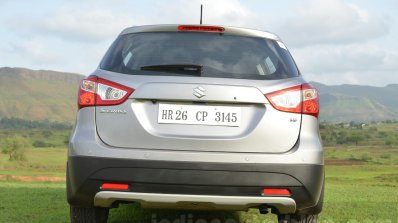Maruti S-Cross - First Drive Review
Introduced at the 2013 Geneva Motor Show, the S-Cross will launch in India in the first week of August, Maruti confirmed at the recently-held media drive event. While in the European market, the S-Cross (known as the SX4 S-Cross) replaced the previous generation SX4 hatchback (what was sold in India in a sedan bodystyle), it intends on launching Maruti into the crossover segment.
Exterior:

For the Indian market, the S-Cross gets a dual-chrome grille up front, and rather toned down 16-inch alloy wheels. The rest of the car looks identical to the model sold in Europe. Taking note that design is subjective, we are of the opinion that the S-Cross lacks the road presence of the Renault Duster, the upcoming Hyundai Creta or even the Ford EcoSport for that matter.

Bottomline: The S-Cross looks more like a pseudo-hatchback than a crossover, which would let people to think that it competes with the Hyundai i20 Active and Fiat Avventura, than say with an SUV like the Duster or Creta.
The S-Cross for India measures 4.30 meters in length, 1.765 meters in width, 1.59 meters in height and 2.6 meters in wheelbase. It has a ground clearance of 180 mm, and all variants are shod with 205/60 R16 tyres.
Interior:

The design of the dashboard is identical to the European S-Cross, save for a few minor differences. The talking point of the interior is the 7-inch touchscreen Maruti SmartPlay entertainment and navigation system, which has some room for improvement. The navigation especially doesn’t feel intuitive to use.
The driver of the S-Cross will have no problems adjusting to controls if he/she has experienced a modern Maruti product, like the Swift, Dzire or Ciaz. As always, positive and negative things can be inferred here. The positive thing being that certain owners, who have upgraded from a Maruti, would love the familiarity in the cabin of the S-Cross.

On the downside, build quality is Swift-like, with certain controls feeling too hard and plasticky for a car that will cost over INR 10 lakhs. It’s high time Suzuki differentiates parts and build quality within its products.
What we love about the S-Cross are its seats. The front seats feel supremely comfortable with the right amount of under thigh and lumbar support. The rear seats also feel comfortable, but for a car measuring 4.3 meters long, rear legroom could have been more generous.

The S-Cross has a rectangular, well-shaped boot which can accommodate 353 liters (810 liters when the rear split seats are folded).
Our top-end S-Cross DDiS 320 Alpha came loaded with HID projector headlights, LED daytime running lights, 16-inch alloy wheels, reverse camera and parking sensors, smart entry with push button start, cruise control, Bluetooth, a 7-inch touchscreen Maruti SmartPlay entertainment system with navigation, automatic day/night rear view mirror, electrically-adjustable wing mirrors with power folding feature, automatic climate control and leather seats. Rear AC vents are not offered on any model.
Engine and Gearbox:

The S-Cross will be offered with two diesel engines sourced from Fiat. The entry-level is the tried-and-tested 1.3-liter MultiJet in the 90 PS/200 Nm tune matched to a 5-speed manual transmission.
The version we drove was fitted with the 1.6-liter MultiJet engine (fully imported into India) capable of 120 PS and 320 Nm of torque paired to a 6-speed manual gearbox.
The engine settles into a quiet idle and NVH levels are indeed commendable. To put these levels into perspective, the NVH of the S-Cross 1.6 feels a tad more refined than a Swift diesel, but the Creta 1.6 diesel we drove earlier is still a step ahead.
Flat out, the S-Cross 1.6 will hit 100 km/h in 11.3 seconds, claims Maruti. What we can tell you is that this engine needs time until 1,750 rpm to get a move-on. Progress between 1,750-4,000 rpm is extremely punchy, and dare we say addicting. However, below this point, this unit feels bogged down, forcing one to downshift for overtaking maneuvers.

For a clutch that handles 320 Nm, the pedal feels rather light, and driving the S-Cross in bumper-to-bumper traffic shouldn’t take a toll on your left foot. That being said, Maruti is missing out on the AT bandwagon, given the S-Cross comes only with a manual transmission. It is worthy to note that the Euro-spec S-Cross, powered by the same engine, was recently given a 6-speed AMT with twin clutches, dubbed by Suzuki as TCSS (Twin Clutch System by Suzuki).
Ride and Handling:

The S-Cross strikes a fine balance in the ride and handling department. At city speeds, the S-Cross adapts well to bad roads, though the ride quality is still a step below the Renault Duster.
The handing department is one of the forte’s of the S-Cross. The chassis feels stiff and well balanced, and driving the S-Cross does remind one of the Swift, which is certainly a good thing. Body roll is well contained, and the steering feedback is second to none, which had us wishing all the more for the 1.6-liter petrol engined S-Cross sold in the European market.

Another thing which stood out in our test drive was the high speed stability of the car. Even at speeds north of 100 km/h, the S-Cross inspires confidence in a way the Duster does not manage. Add to that the comfortable seats, the tall 6th gear and cruise control and the S-Cross could be the ideal family car for extended weekends.
While we’re all praises for the S-Cross’s driving dynamics, we think the car is in need of grippier rubber as it takes little to induce a squeal on the JK Elanzo-NXTs.
Brakes and Safety:

The top-end S-Cross gets disc brakes at the front and rear which are very reassuring and powerful under use. There are no nasty surprises in this department, though we would have preferred grippier tyres on the car.
All variants of the S-Cross will get a driver airbag. Starting from the second variant (in the DDiS 200), the S-Cross will also pack a co-driver airbag, rear disc brakes and ABS. We think Maruti has taken a wise call in the safety aspect of this car.
Fuel Efficiency:

The S-Cross DDiS 320 is claimed at 22.7 km/l, while the lesser powerful DDiS 200 claims 23.65 km/l. Our brief test drive of the former saw an average fuel efficiency of 15 km/l on the on-board display.
Prices and Sales:
We get the indication that the S-Cross will be priced at a premium over the Ciaz, whose diesel variant starts at INR 8.25 lakhs, ex-Showroom, New Delhi. Further, localization levels of the S-Cross DDiS 320 are only 67 percent, as the engine is fully imported.

The S-Cross will be sold exclusively through the NEXA dealerships. For prospective buyers in cities where there are no NEXA dealerships, the Maruti dealer in the city will arrange the sale of the S-Cross through the NEXA dealership it is partnered with (all NEXA dealerships will be run by existing Maruti dealer partners). With a promise to setup 100 NEXA dealers by the end of this financial year, Maruti says they’ll have about 85 percent of the S-Cross’s target audience (mainly Tier I and II cities) covered.
Verdict:
The S-Cross is a difficult car to sum up: It comes across as a pseudo-hatchback but with a more powerful engine than the competition. That being said, buyers on the lookout for a crossover like the Duster or the Creta may not be impressed with the S-Cross, owing to its toned-down design and average build quality.
What we really love about the S-Cross are its driving manners, comfortable seats and punchy diesel engine. The feature list has also been well thought out, and being a Maruti, customers will enjoy unmatched after-sales service.
As a feature-packed large and powerful hatchback, the S-Cross has potential to appeal to the enthusiast who has otherwise been restricted to the Polos and the i20s. Rather than calling it a crossover, the S-Cross, safe to say, is India’s first C-segment hatchback (non-luxury segment), and the rugged styling you get on the outside is an icing on the cake.

































































